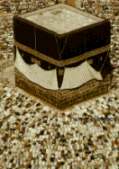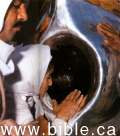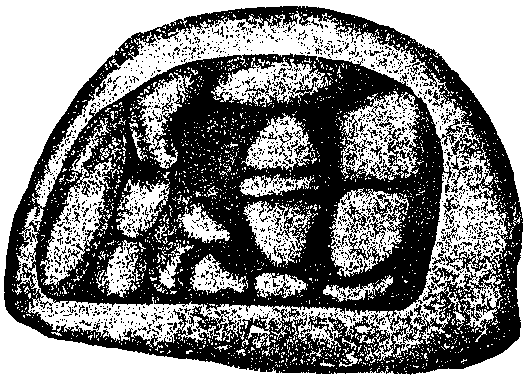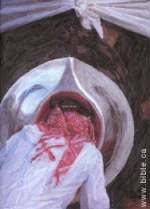A beginners Photo gallery of the Islamic religion.
Are you lost in sorting out what is what and who is who in the Muslim religion?
 The Kaba (Ka'Bah)
The Kaba (Ka'Bah)
(Click on thumbnails for high resolution photographs.)

|
Circling the Kaba 7 times counting from the corner of the Kaba with the black stone. Islamic myth says that the Kaba in Mecca Saudi Arabia, was built by Adam. Muslims also believe solely because the Koran says so, that the revered "black stone" (Alhajar Al-Aswad) is a special divine meteorite, that pre-dates creation and fell at the foot of Adam and Eve. It is presently embedded in the southeastern corner of the Kaba. Muslims touch and kiss the black stone during. When Muslims circle the Kaba 7 times, they use the black stone as the starting point to count. |

|
|

|
click photo here for ultra high resolution |
|

|
Muslims believe (without proof) that the Kaba, in its present location, was built by Adam, and rebuilt by Abraham, Ishmael and Muhammad. It is not known when the Kaba was first build but there are no historical records of the Kaba existing before about 400AD.
|
|
Although it is claimed that the Noaic flood destroyed the Kaba, and was rebuilt by Abraham, the first known reconstruction of the Kaba was by Muhammad's Quraish tribes, while he was still a polytheist worshipping 360 pagan gods. When Muhammad was young (about 600AD), a flash flood damaged the Kaba and its walls were cracked. |

|
|
 |
Once the walls were erected, the Black Stone, (the Hajar ul Aswad) was set in the eastern wall of the Kaba. In addition to flooding, the Kaba was also fixed after several human attacks. The most recent reconstruction of the Kaba was in the 1990's. Muslims claim that the "black stone" is the only remaining stone from the Kaba that Abraham build. |
|
The walls are all made of stone. The stones inside are unpolished, while the ones outside are polished. The Kaba today is a foundation size different than what Abraham was supposed to have built. |
 |
|

|
The ceiling and roof are two levels made out of wood. They were reconstructed with teak, which is capped with stainless steel. Like the Jewish Temple, the size of the Kaba has changed over time. The current height of the Kaba is 39 feet, 6 inches and total size comes to 627 square feet. The inside room of the Kaba is 13 x 9 meters. The Kaba's walls are one meter wide. The floor inside is 2.2 meters higher than the place where people perform Tawaf. |
|
The Kaba is the building towards which Muslims face five times a day, everyday, in prayer. The pagans were already praying 5 times a day towards this Kaba before Muhammad was born. Here are worshippers touching the stones of the Kaba. |

|
|

|
The black cloth that covers the Kaba is very elaborate with gold thread. |
|
The only door of the Kaba with the curtain over it. |
 |
|
What is inside the Kaba?
Dr. Muzammil Siddiqi is the president of the Islamic Society of North America (ISNA). He had the opportunity to go inside the Kaba in October 1998. In an interview with Sound Vision, he described the following features: |
|

|
- there are two pillars inside (others report 3 pillars)
- there is a table on the side to put items like perfume
- there are two lantern-type lamps hanging from the ceiling
- the space can accommodate about 50 people
- there are no electric lights inside
- the walls and the floors are of the marble
- there are no windows inside - there is only one door
- the upper inside walls of the Kaba were covered with some kind of curtain with the Kalima written on it.
|
|
|
|
 The Maqam Ibrahim
The Maqam Ibrahim
(Station of Abraham)
(Click on thumbnails for high resolution photographs.)
|

|
The Maqam Ibrahim is located in front of the only door of the Kaba. Inside the building is a boulder about 2 x 3 feet in size and that claims to have the footprint of Abraham which was imbedded when his foot miraculously sank into the rock when he stood on it. Muslims believe (without proof) that this is the spot where Abraham used to perform prayers near the Kaba. They also believe he used it as a stepping stone to build the kaba. |
|
You can see the symbol of the crescent moon on top of the Maqam Ibrahim beside the Kaba, as well as every mosque in the world. The historical connection with pagan moon worship is obvious. |

|
|

|
You can see the Maqam Ibrahim in this photo, just to the right of the Kaba. |
|
|
|
 The Black Stone
The Black Stone
(Hajar al-Aswad)
(Click on thumbnails for high resolution photographs.)

Occhigrosso (1996) affirms the moon God association and the astronomical basis of the black stone: "Before Muhammad appeared, the Kaaba was surrounded by 360 idols, and every Arab house had its god. Arabs also believed in jinn (subtle beings), and some vague divinity with many offspring. Among the major deities of the pre-Islamic era were al-Lat ("the Goddess"), worshiped in the shape of a square stone; al-Uzzah ("the Mighty"), a goddess identified with the morning star and worshiped as a thigh-bone-shaped slab of granite between al Talf and Mecca; Manat, the goddess of destiny, worshiped as a black stone on the road between Mecca and Medina; and the moon god, Hubal, whose worship was connected with the Black Stone of the Kaaba. The stones were said to have fallen from the sun, moon, stars, and planets and to represent cosmic forces. The so-called Black Stone (actually the color of burnt umber) that Muslims revere today is the same one that their forebears had worshiped well before Muhammad and that they believed had come from the moon. (No scientific investigation has ever been performed on the stone. In 930, the stone was removed and shattered by an Iraqi sect of Qarmatians, but the pieces were later returned. The pieces, sealed in pitch and held in place by silver wire, measure about 10 inches in diameter altogether and several feet high; they are venerated today in patched-together form.)" (Peter Occhigrosso, 1996 The Joy of Sects)
|

|
Muslims believe (without proof) that the revered "black stone" (Alhajar Al-Aswad) is a special divine meteorite, that pre-dates creation that fell at the foot of Adam and Eve. It is presently embedded in the southeastern corner of the Kaba. Muslims touch and kiss the black stone during Hajj but non-Muslims are strictly forbidden to even touch it. |
|
The stone has been attacked many times and is now composed of several pieces and fragments, bound together by a silver ligature. It is semicircular and measures about ten inches horizontally and twelve inches vertically. Here a woman and her husband touch the stone. |

|
|

|
It is presently embedded in the southeastern corner of the Kaba. Muslims touch and kiss the black stone during Hajj but non-Muslims are strictly forbidden to even touch it. |
|
|
|
 The "Stand" on Mount Arafat
The "Stand" on Mount Arafat
(Click on thumbnails for high resolution photographs.)
|
 |

|
|

|
On the 9th of Dhu al-Hijjah pilgrims leave Mina for the plain of 'Arafat for the wuquf, "the standing," the central rite of the hajj. In a re-enactment rite based upon a story of Muhammad, all are required to stand from midday to sunset in the very hot sun meditating. God told Christians such rites are valueless: "These are matters which have, to be sure, the appearance of wisdom in self-made religion and self-abasement and severe treatment of the body, but are of no value against fleshly indulgence." Col 1:23 |
|
The plain of Arafat at the Mount of Mercy, is where Muhammad is supposed to have delivered his Farewell Sermon. |

|
|
|
|
 The "Stone Throw" in Mina (the Rummy)
The "Stone Throw" in Mina (the Rummy)
(Click on thumbnails for high resolution photographs.)
|
The throw: (the Rummy) Pilgrims walk to Mina where they throw 7 stones at stone pillars which represent the devil. This is based upon a mythical event in the life of Abraham. The Koran says that Abraham was told by God to sacrifice his only begotten son Ishmael. (all world history and the Bible says Isaac). On the way to make the sacrifice, the devil tried to convince Abraham not to sacrifice Ishmael. Abraham gathered up some stones and threw them at the devil until he disappeared. So Pilgrims throw 7 stones at the stone pillars in Mina which represent evil and the devil, reenacting the way Abraham threw stones at the Devil. |

|
|

|
The "Stone Throw" in Mina re-enactment ritual based upon an mythical event in the life of Abraham. The devil tried to talk Abraham out of sacrificing Ishmael (the Bible says Isaac). So Abraham threw stones at the devil till he disappeared. |
|
Likewise, pilgrims stop at Mina to throw seven small stones at stone pillars which represent evil and the devil. |

|
|

|
 |
|
|
|
 The "running"(The Sai) between Safa and Marwat
The "running"(The Sai) between Safa and Marwat
(Click on thumbnails for high resolution photographs.)
|
|
The Run (the Sai): The pilgrim is required to make several brisk walks between the hills of Safa and Marwat in a re-enactment ritual based upon a mythical event in the life of Hagar and Ishmael. Muslims believe that these two hills of Safa and Marwat are where Hagar frantically ran back and forth seven times in search of water for her dying son, Ishmael. Hagar's found water to save Ishmael at the "well of Zamzam". So Pilgrims run back and forth between two hills of Safa and Marwat seven times and then go to the Zamzam well, beside Kaba. |
|

|
The pilgrim is required to make several walks between the hills of Safa and Marwat in a re-enactment ritual. Muslims believe (without proof) that these two hills are where Hagar frantically ran back and forth seven times in search of water for her dying son, Ishmael. |
|
Hagar's found water to save Ishmael at the "well of Zamzam". The area has been developed into a covered portico similar to an underground parking lot. |

|
|
|
|
 Ihram dress
Ihram dress
(Click on thumbnails for high resolution photographs.)
|

|
Ihram dress
Pilgrims must shower, perfumes his body, but not his garments, (women use no perfume at all) and puts on two pieces of unsewn seamless white cloth. |
|
|
|
 Dome of the Rock
Dome of the Rock
(Click on thumbnails for high resolution photographs.)
|

|
The dome of the rock on the Jewish temple site in Jerusalem was built by Abd al-Malik in 691AD. Muslims believe it is where the prophet Muhammad ascended to heaven in a vision and later actually visited. |
|
|
|
 Eating Camel sacrifice
Eating Camel sacrifice
(Click on thumbnails for high resolution photographs.)
|

|
As required, pilgrims eat a succulent dish of baby camel meat, roasted whole, served during the feasts at the end of Hajj. |
|
|
|
Written by Brother Andrew

Go To Start: WWW.BIBLE.CA

![]() The Kaba (Ka'Bah) (The Tawaf: 7 times round)
The Kaba (Ka'Bah) (The Tawaf: 7 times round)![]() The Black Stone
The Black Stone![]() Maqam Ibrahim
Maqam Ibrahim![]() The "Stand" on Mount Arafat
The "Stand" on Mount Arafat![]() The "Stone Throw" in Mina (the Rummy)
The "Stone Throw" in Mina (the Rummy)![]() The "Run" between Safa and Marwat (The Sai)
The "Run" between Safa and Marwat (The Sai)![]() Ihram dress
Ihram dress![]() Dome of the Rock
Dome of the Rock![]() Eating camel sacrifice
Eating camel sacrifice 
































